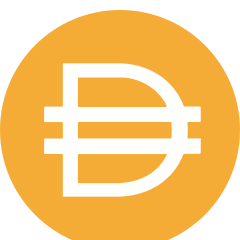
Dai
About Dai
The price of Dai (DAI) is $0.99609790 today, as of Nov 17 01:42 a.m., with a 24-hour trading volume of $62.59M. Over the last 24 hours, the price has decreased by -0.24%. Dai currently has a circulating supply of 3.31B and a market cap of $3.29B.
Dai is a stablecoin whose value is pegged to the U.S. dollar, which means it is shielded from the wild swings in prices that are typically associated with a cryptocurrency.
Users generate dai by depositing ether, which is the native cryptocurrency of the Ethereum blockchain, as collateral into Maker Vaults, enabling dai to be minted and entered into circulation. It essentially works like a loan. Users lock up their ether (deposit it into a smart contract) and receive DAI in return. Borrowers can withdraw their locked ether only after they have repaid the amount of dai plus a small interest fee.
The Maker Protocol is the set of smart contracts that make it possible to generate dai, which is held in digital wallets and supported on Ethereum and other blockchains. Smart contracts are self-executing computer programs that automatically complete functions when certain conditions trigger them.
Dai was launched in December 2017, almost three years after its governing decentralized autonomous organization (DAO) called MakerDao was created (see below).
Because the cryptocurrency is pegged to the dollar, dai’s price typically remains around the $1 mark. However, there have been times when its price has shifted away from that level. That usually happens when supply and demand for the stablecoin changes. When supply is high but demand is low, dai’s price tends to hover beneath $1, and vice versa.
Dai hit an all-time high of $1.14 in September 2020, and an all-time low of $0.8935 in June 2021.
Dai doesn’t have a maximum supply, as it is issued on demand by those who provide the necessary collateral. Dai has a burning mechanism that can be triggered by users who are in debt when they repay the principal of their loan value. However, interest payments – also paid in dai – will recirculate onto the open market.
The stablecoin can be issued only when users submit the proper collateral at the indicated collateralization rate.
